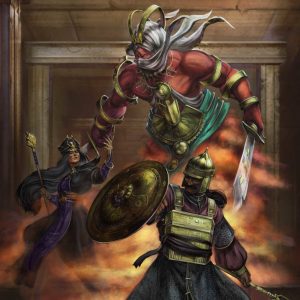Situated in the centre of Galania Trans Sinia, Vercy is known as the Garden City. The reason for this becomes quickly apparent as soon as one lays eyes on it. Built in the centre of a vast plain, many called Vercy the Emperor’s Folly. Having decided that Argem in the summer was too humid and hot, a very young Emperor Ludwig II, sought to build a palace in what he hoped would become the summer capital of the Empire. The location of Vercy was chosen for its location, roughly central to the Hundred Kingdoms, rather than any salient geographical feature or socioeconomic aspect. When the nobility, particularly those familiar with the geography of the area heard of the location, they scoffed at the notion that the plan would succeed.
Enraged by the dismissal of his grand vision Ludwig (who would be remembered as one of the more eccentric and excitable Emperors… also one of the most memorable) doubled down on his claim. If the region were not beautiful or interesting he would make it so. If nothing grew there, he would ensure he possessed the most lush and beautiful gardens in the Empire. He was true to his word.
The Summer Palace of the Emperor is a veritable city onto itself. A fantastical confection of marbled pillars, frescoes patios and massive windows. Hundreds of rooms and dozens of halls stand over a warren of servant’s quarters and store rooms. But that is not even the most impressive part of the palace. The Emperor was true to his word, and fashioned a garden like none other before it. Fashioned with the aid of the Mason’s Guild it is the world’s largest greenhouse with a dozen separate halls catering to a dozen different environments. Staffed at all times with no less than four Gifted practitioners who ensure the environment remains stable and constant, making the Imperial Gardens one of the wonders of Ea.
Once the palace was complete, the Emperor moved his court there and refused to return to Argem. Slowly but surely, the nobility was forced to accede to the Emperor’s whim and relocated to Vercy. All of the great houses ultimately built palaces simply to be close to the Emperor (take into account that during the reign of Ludwig II the Empire was approaching the zenith of its power and the Emperor’s wealth and power were unequalled) and slowly the Emperor’s vision came to be and Vercy became a city of palaces, walled by a wooded park that took decades to complete.
Today the city stands much as it did in the heyday of the Empire. While succeeding Emperors moved the capital back to Argem, many saw the value in holding a traveling court, with Vercy by far the most common destination. With the collapse of the Empire, one would have thought that Very would vanish, but the opposite is true.
Following the death of the last Emperor the Conclave, eager to distance itself from the Chamberlain’s centre of power, decided that the Conclaves would henceforth be hosted in Vercy. As a result, Vercy has a permanent population of courtiers and diplomats from all of the major houses year round. In fact, holding a palace in Vercy has in many ways become a mark of prestige and a statement that the House owning it considers themselves a claimant for the throne, each striving to outdo the other with ever more extravagant decorations and renovations. Patroled by a city guard composed of members of each house whose exact composition are determined by the level of contributions each House makes to the city itself (ensuring it is one of the best funded and managed environments in the Hundred Kingdoms),Vercy has remained inviolate to this day as none dare tempt the wrath of the Hundred Kingdoms… and frankly would have no tactical gain beyond the plunder captured.
However Vercy is far from a paradisiacal environment. All of these palaces required a veritable army of servants and attendants to run, who in turn required countless others to provide for their needs. Unwilling to let the unwashed masses sully his creation, Ludwig decreed that the lay population of Vercy would live within four cantons in the outskirts of the city which his architects would design. Aware of the tendency of these slums to sprawl, he demarcated their limits with sturdy stone walls and had his city planners lay out the cities, issuing a decree that the number of buildings within each canton could not be changed to ensure their picturesque character.
Unfortunately the Emperor could not have foreseen the results of his decrees generations down the line as the populations of the cantons exploded. Limited to extending already existing buildings the commoners dug as deep as they could, and built as high as they could. They even interpreted the walls as being buildings, and built attop those as well! Each of these four cantons is now a bustling hive of human activity and ramshackle construction where sunlight cannot reach the street for the sheer profusion of buildings leaning over the street. The canton’s entire economy revolves around fulfilling the needs of the gentry who live in the palaces. While butchers, slaughterhouses and honest craftsmen dominate trade by day, at night it is the world famous gabling dens and bordellos and other darker service providers that dominate the scene. It should come as no surprise that the cantons have become a haven of organized crime, with each canton controlled by a number of gangs and syndicates who ceaselessly vie for power and influence in the shadows, providing a stark contrast to the well patrolled and brightly lit boulevards and parks less than a few hundred meters away.












